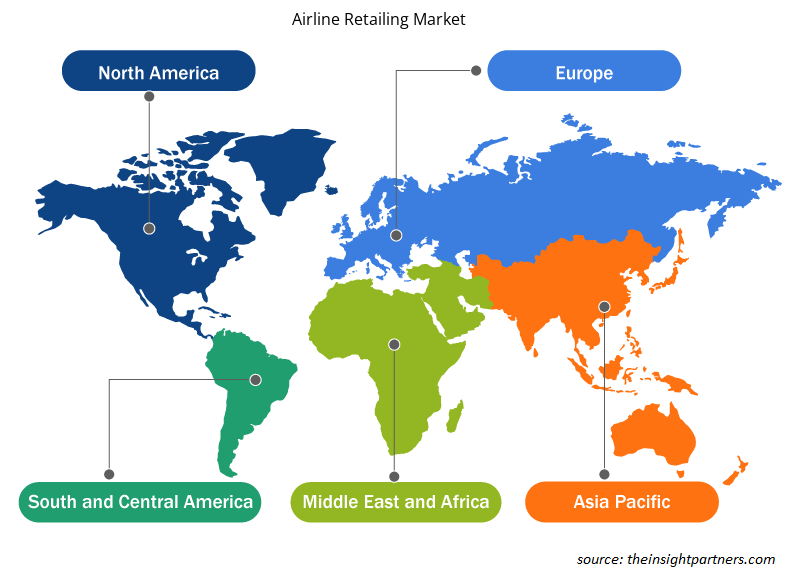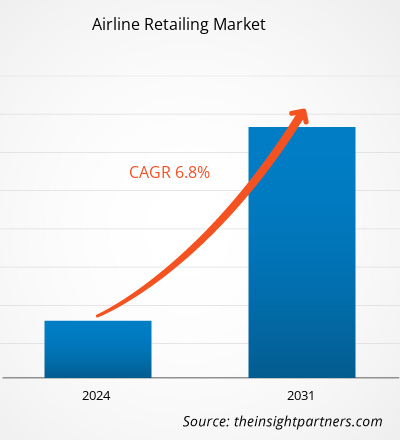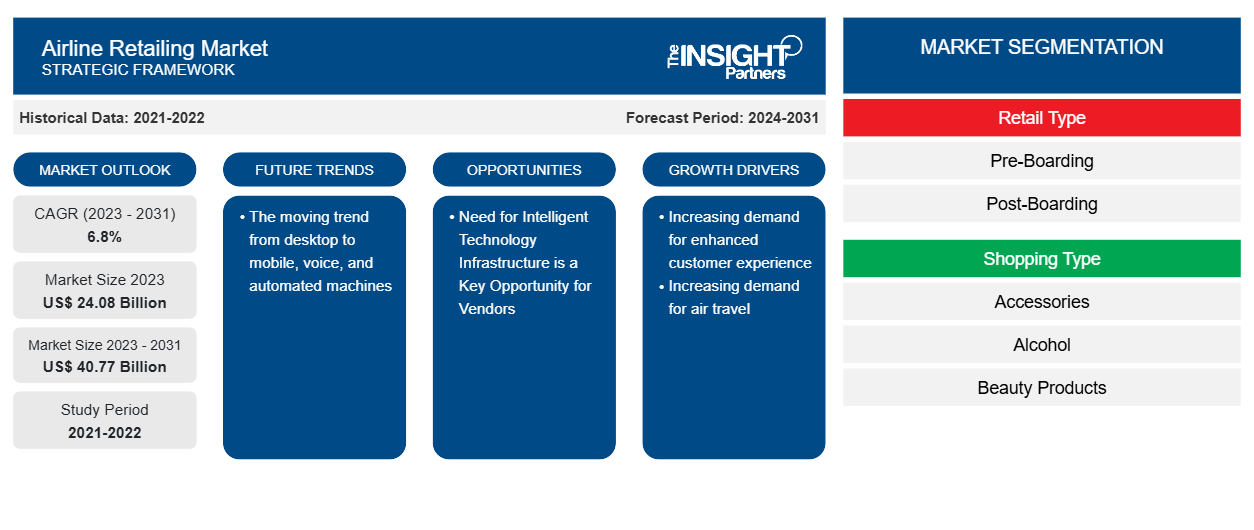Der Airline-Retailing-Markt soll von 24,08 Milliarden US-Dollar im Jahr 2023 auf 40,77 Milliarden US-Dollar im Jahr 2031 anwachsen. Der Markt soll zwischen 2023 und 2031 eine durchschnittliche jährliche Wachstumsrate (CAGR) von 6,8 % verzeichnen. Der Trend vom Desktop hin zu Mobilgeräten, Sprachdiensten und automatisierten Maschinen dürfte ein wichtiger Trend auf dem Markt bleiben.
Airline-Einzelhandelsmarktanalyse
Der Einzelhandel treibt einen Wandel in der Art und Weise voran, wie Reisen gekauft werden. Im weiteren Sinne haben Einzelhändler fortschrittliche Merchandising-Praktiken eingeführt, um ihre Kunden besser bedienen zu können. Außerdem entdecken Fluggesellschaften neue Formen von Reisedienstleistungen, um ihren Passagieren einen Mehrwert zu bieten und die Rentabilität zu steigern. Der Einzelhandel der Fluggesellschaften trägt dazu bei, den Umsatz der Fluggesellschaften zu steigern und gleichzeitig die Kundenzufriedenheit zu verbessern. Die Fluggesellschaften bieten Einzelhandelsdienste auf zwei verschiedene Arten an, nämlich vor und nach dem Boarding. Einige Fluggesellschaften bieten beide Arten an, andere wiederum nur eine der genannten Arten.
Überblick über den Airline-Einzelhandelsmarkt
Mehrere Fluggesellschaften bieten im aktuellen Marktszenario sowohl Pre-Boarding- als auch Post-Boarding-Verkäufe an. Das Pre-Boarding-Verkaufssegment hat den Markt in den letzten Jahren dominiert und wird voraussichtlich auch in den kommenden Jahren den Airline-Einzelhandelsmarkt antreiben. Dies liegt daran, dass einige Fluggesellschaften die In-Flight-Merchandising-Optionen für ihre gesamte Flotte streichen. Dies führt zu einer stärkeren Betonung des Pre-Boarding-Segments. Verschiedene Fluggesellschaften haben ihre eigenen Einzelhändler mit bedeutenden Produktlinien. Beispielsweise bietet der Eigenhändler KrisShop Pte. Ltd. von Singapore Airlines ein umfangreiches Sortiment an Parfüms, Taschen, Elektronik, Uhren sowie Wein und Spirituosen, um nur einige zu nennen. Ebenso ist der British Airways High Life Shop ein Eigenhändler von British Airways, der ein besonders großes Produktsortiment anbietet. Verschiedene Fluggesellschaften ohne eigene Einzelhändler arbeiten mit Einzelhändlern zusammen.
Passen Sie diesen Bericht Ihren Anforderungen an
Sie erhalten kostenlose Anpassungen an jedem Bericht, einschließlich Teilen dieses Berichts oder einer Analyse auf Länderebene, eines Excel-Datenpakets sowie tolle Angebote und Rabatte für Start-ups und Universitäten.
-
Holen Sie sich die wichtigsten Markttrends aus diesem Bericht.Dieses KOSTENLOSE Beispiel umfasst eine Datenanalyse von Markttrends bis hin zu Schätzungen und Prognosen.
Treiber und Chancen im Airline-Retailing-Markt
Steigende Nachfrage nach verbesserter Kundenerfahrung
Der Flugsektor ist ein hart umkämpfter Markt. Die Betriebskosten der Fluggesellschaften sind sehr hoch und die Nachfrage unterliegt erheblichen saisonalen Schwankungen. Angesichts der steigenden Zahl von Fluggesellschaften suchen Unternehmen nach Alternativen, die den Fluggesellschaften helfen könnten, sich auf dem wettbewerbsintensiven Markt einen Vorteil zu verschaffen. Um sich einen Marktvorteil zu verschaffen, konzentrieren sich Fluggesellschaften stark darauf, ihre Dienstleistungen für eine hohe Kundenzufriedenheit zu verbessern.
Fortschrittliche Technologie und Kundenintelligenz eröffnen neue Möglichkeiten zur Verbesserung des Kundenerlebnisses. Die Implementierung von Kundenintelligenz eröffnet neue Möglichkeiten für den Airline-Einzelhandel. Die Fluggesellschaft verfügt über ein engagiertes Publikum und umfassende Kundenkenntnisse, die durch digitale Anwendungen ermöglicht werden und mit intelligenten und unterhaltsamen In-Flight- Einzelhandelsmöglichkeiten, die emotionale Impulse setzen, stimuliert werden können. Die meisten Fluggesellschaften befinden sich in der Lernphase, wenn es um Einzelhandelsmöglichkeiten geht. Mit externen Neueinstellungen, die Erfahrung im Einzelhandel haben, verbessern die Fluggesellschaften ihre Einzelhandelsleistung. Die Nutzung von Big Data wirkt sich auch auf den Airline-Einzelhandel aus und optimiert den Kundenwert und das Kundenerlebnis. Die Einführung fortschrittlicher Technologien und die steigende Nachfrage nach einem verbesserten Kundenerlebnis treiben den Airline-Einzelhandelsmarkt erheblich voran.
Der Bedarf an intelligenter Technologieinfrastruktur ist eine wichtige Chance für Anbieter
Um in einem kundenorientierten Umfeld zu agieren, konzentrieren sich Fluggesellschaften auf die Implementierung intelligenter Einzelhandelslösungen und schaffen eine potenzielle Nachfrage nach intelligenter Technologieinfrastruktur. Die intelligente Technologieinfrastruktur kombiniert künstliche Intelligenz (KI), maschinelles Lernen (ML), ausgefeilte Operations-Research-Modelle (OR) und Kundendaten, um relevante Erkenntnisse zu liefern. Die Kundendaten ermöglichen es Fluggesellschaften, das Verbraucherverhalten zu identifizieren, zu analysieren und vorherzusagen.
Intelligente Technologie ermöglicht es Abteilungen außerdem, die Synchronisierung von Zeitplänen zu ermöglichen, Zeitpläne schneller bereitzustellen, um den Umsatz zu steigern und die Empfehlungskosten zu senken, Flugpreise automatisch zu überwachen und zu analysieren, personenbasierte Paketangebote für Flug und Zusatzleistungen bereitzustellen, Preisempfehlungen bereitzustellen, die die Verfügbarkeit auf mehreren Kanälen nutzen und gegen abrupte Marktänderungen abgeschirmt sind, sowie personalisierte Angebote und Dienste bereitzustellen, die über alle Kanäle hinweg konsistent sind.
Segmentierungsanalyse des Airline-Einzelhandelsmarktberichts
Wichtige Segmente, die zur Ableitung der Marktanalyse für den Fluglinieneinzelhandel beigetragen haben, sind Einzelhandelstyp, Einkaufstyp und Transporttyp.
- Basierend auf der Einzelhandelsart ist der Airline-Einzelhandelsmarkt in Pre-Boarding und Post-Boarding segmentiert. Das Pre-Boarding-Segment hatte im Jahr 2023 einen größeren Marktanteil.
- Basierend auf der Einkaufsart ist der Airline-Einzelhandelsmarkt in Accessoires, Alkohol, Schönheitsprodukte , Handelswaren und Sonstiges segmentiert. Das Handelswarensegment hielt im Jahr 2023 einen größeren Marktanteil.
- Basierend auf dem Carriertyp ist der Airline-Einzelhandelsmarkt in Full-Service-Carrier und Low-Cost-Carrier segmentiert. Das Segment der Full-Service-Carrier hatte im Jahr 2023 einen größeren Marktanteil.
Marktanteilsanalyse im Airline-Einzelhandel nach geografischer Lage
Der geografische Umfang des Berichts zum Airline-Einzelhandelsmarkt ist hauptsächlich in fünf Regionen unterteilt: Nordamerika, Europa, Asien-Pazifik, Naher Osten und Afrika sowie Südamerika.
Der asiatisch-pazifische Raum dominierte den Markt im Jahr 2023, gefolgt von den Regionen Nordamerika und Europa. Darüber hinaus wird der asiatisch-pazifische Raum in den kommenden Jahren wahrscheinlich auch die höchste durchschnittliche jährliche Wachstumsrate verzeichnen. China dominierte 2023 den asiatisch-pazifischen Airline-Einzelhandelsmarkt. Der asiatisch-pazifische Raum umfasst einige der am schnellsten wachsenden Volkswirtschaften der Welt wie China und Indien. Darüber hinaus ist Japan das technologisch fortschrittlichste Land der Region, was die Möglichkeit für die Entwicklung und Bereitstellung von IoT-/Smart-Lösungen in der Region bietet. Auch die aufstrebenden Volkswirtschaften Asiens wie Südkorea, Taiwan, Singapur und andere erleben ein Wachstum ihres technologischen und intelligenten Trends und treiben so das Wachstum verschiedener Dienstleistungen voran. Darüber hinaus haben die Entwicklungsländer im asiatisch-pazifischen Raum in den letzten Jahren ein exponentielles Wachstum ihrer Volkswirtschaften erlebt. Dies hat auch zu höheren Beschäftigungsquoten sowie zu höheren verfügbaren Einkommen der Einzelpersonen geführt. Hohe verfügbare Einkommen haben es der Mittelschicht und der oberen Mittelschicht in den Ländern ermöglicht, luxuriöse Dienstleistungen wie Flugreisen in Anspruch zu nehmen. Die Zahl der Passagiere, die in diesen Ländern mit dem Flugzeug reisen, ist deutlich gestiegen.
Regionale Einblicke in den Airline-Einzelhandelsmarkt
Die regionalen Trends und Faktoren, die den Airline-Retailing-Markt im Prognosezeitraum beeinflussen, wurden von den Analysten von Insight Partners ausführlich erläutert. In diesem Abschnitt werden auch die Marktsegmente und die Geografie des Airline-Retailing-Marktes in Nordamerika, Europa, im asiatisch-pazifischen Raum, im Nahen Osten und Afrika sowie in Süd- und Mittelamerika erörtert.

- Erhalten Sie regionale Daten zum Airline-Einzelhandelsmarkt
Umfang des Airline-Einzelhandelsmarktberichts
| Berichtsattribut | Details |
|---|---|
| Marktgröße im Jahr 2023 | 24,08 Milliarden US-Dollar |
| Marktgröße bis 2031 | 40,77 Milliarden US-Dollar |
| Globale CAGR (2023 - 2031) | 6,8 % |
| Historische Daten | 2021-2022 |
| Prognosezeitraum | 2024–2031 |
| Abgedeckte Segmente |
Nach Einzelhandelstyp
|
| Abgedeckte Regionen und Länder |
Nordamerika
|
| Marktführer und wichtige Unternehmensprofile |
|
Dichte der Akteure im Airline-Einzelhandel: Die Auswirkungen auf die Geschäftsdynamik verstehen
Der Airline-Retailing-Markt wächst rasant, angetrieben durch die steigende Endverbrauchernachfrage aufgrund von Faktoren wie sich entwickelnden Verbraucherpräferenzen, technologischen Fortschritten und einem größeren Bewusstsein für die Vorteile des Produkts. Mit steigender Nachfrage erweitern Unternehmen ihr Angebot, entwickeln Innovationen, um die Bedürfnisse der Verbraucher zu erfüllen, und nutzen neue Trends, was das Marktwachstum weiter ankurbelt.
Die Marktteilnehmerdichte bezieht sich auf die Verteilung der Firmen oder Unternehmen, die in einem bestimmten Markt oder einer bestimmten Branche tätig sind. Sie gibt an, wie viele Wettbewerber (Marktteilnehmer) in einem bestimmten Marktraum im Verhältnis zu seiner Größe oder seinem gesamten Marktwert präsent sind.
Die wichtigsten auf dem Airline-Einzelhandelsmarkt tätigen Unternehmen sind:
- Air France/ KLM
- AirAsia Group Berhad
- British Airways Plc
- Deutsche Lufthansa AG
- Easy Jet PLC
- Korean Air Lines Co., Ltd
Haftungsausschluss : Die oben aufgeführten Unternehmen sind nicht in einer bestimmten Reihenfolge aufgeführt.

- Überblick über die wichtigsten Akteure im Airline-Einzelhandelsmarkt
Nachrichten und aktuelle Entwicklungen zum Airline-Einzelhandelsmarkt
Der Airline-Einzelhandelsmarkt wird durch die Erhebung qualitativer und quantitativer Daten nach Primär- und Sekundärforschung bewertet, die wichtige Unternehmenspublikationen, Verbandsdaten und Datenbanken umfasst. Nachfolgend sind einige der Entwicklungen im Airline-Einzelhandelsmarkt aufgeführt:
- Die in Gatwick ansässige Kurzstreckentochter von British Airways, BA Euroflyer, hat die für Kunden verfügbaren Kaufoptionen im Euro Traveller (Economy) erweitert und neue saisonale Menüs im Club Europe (Business Class) eingeführt. Die Fluggesellschaft hat in Zusammenarbeit mit ihrem Einzelhandelspartner Tourvest ihr Angebot an Bord erweitert, indem sie neue Kaufoptionen für Kunden während des Fluges eingeführt hat. Bisher konnten Kunden während ihrer Reise nur frische Lebensmittel vorbestellen oder Snacks kaufen. Zu den neuen Optionen für Kunden gehören frische Tom Kerridge Chicken Coronation-Sandwiches und Sweet & Spicy Falafel-Wraps, die an Bord ohne Vorbestellung gekauft werden können. Kunden können dies mit Jimmy's Iced Coffee oder Punchy-Erfrischungsgetränken kombinieren. (Quelle: British Airways, Pressemitteilung, April 2023)
- Qatar Airways führt an Bord neue Menüpunkte ein, die von lokalen Biobauernhöfen in Katar stammen. Die neuesten köstlichen Ergänzungen der Fluggesellschaft sind für Passagiere verfügbar, die bis März 2024 von Doha aus reisen. (Quelle: Qatar Airways, Pressemitteilung, November 2023)
Marktbericht zum Airline-Einzelhandel – Umfang und Ergebnisse
Der Bericht „Marktgröße und Prognose für den Airline-Einzelhandel (2021–2031)“ bietet eine detaillierte Analyse des Marktes, die die folgenden Bereiche abdeckt:
- Marktgröße und Prognose für den Airline-Einzelhandel auf globaler, regionaler und Länderebene für alle wichtigen Marktsegmente, die im Rahmen des Berichts abgedeckt sind
- Markttrends im Airline-Einzelhandel sowie Marktdynamiken wie Treiber, Beschränkungen und wichtige Chancen
- Detaillierte Porter-Fünf-Kräfte-Analyse
- Marktanalyse für Airline-Einzelhandel, die wichtige Markttrends, globale und regionale Rahmenbedingungen, wichtige Akteure, Vorschriften und aktuelle Marktentwicklungen umfasst
- Branchenlandschaft und Wettbewerbsanalyse, die die Marktkonzentration, Heatmap-Analyse, prominente Akteure und aktuelle Entwicklungen im Airline-Einzelhandelsmarkt umfasst
- Detaillierte Firmenprofile
- Historische Analyse (2 Jahre), Basisjahr, Prognose (7 Jahre) mit CAGR
- PEST- und SWOT-Analyse
- Marktgröße Wert/Volumen – Global, Regional, Land
- Branchen- und Wettbewerbslandschaft
- Excel-Datensatz
Aktuelle Berichte
Erfahrungsberichte
Grund zum Kauf
- Fundierte Entscheidungsfindung
- Marktdynamik verstehen
- Wettbewerbsanalyse
- Kundeneinblicke
- Marktprognosen
- Risikominimierung
- Strategische Planung
- Investitionsbegründung
- Identifizierung neuer Märkte
- Verbesserung von Marketingstrategien
- Steigerung der Betriebseffizienz
- Anpassung an regulatorische Trends























 Kostenlose Probe anfordern für - Airline-Einzelhandelsmarkt
Kostenlose Probe anfordern für - Airline-Einzelhandelsmarkt